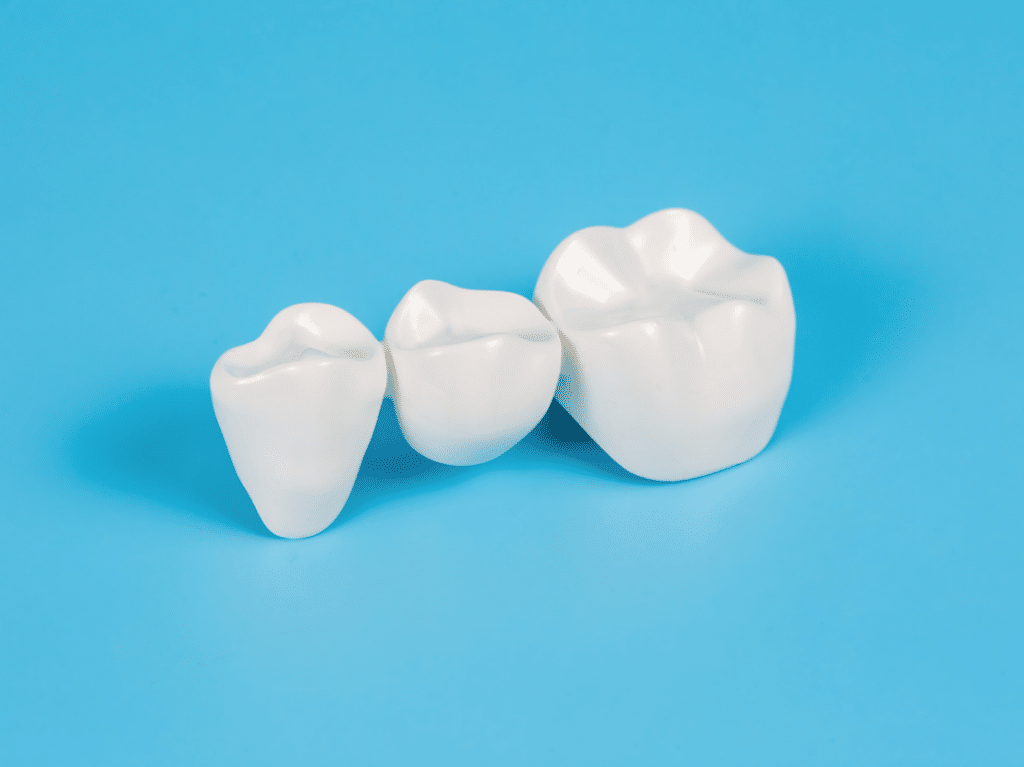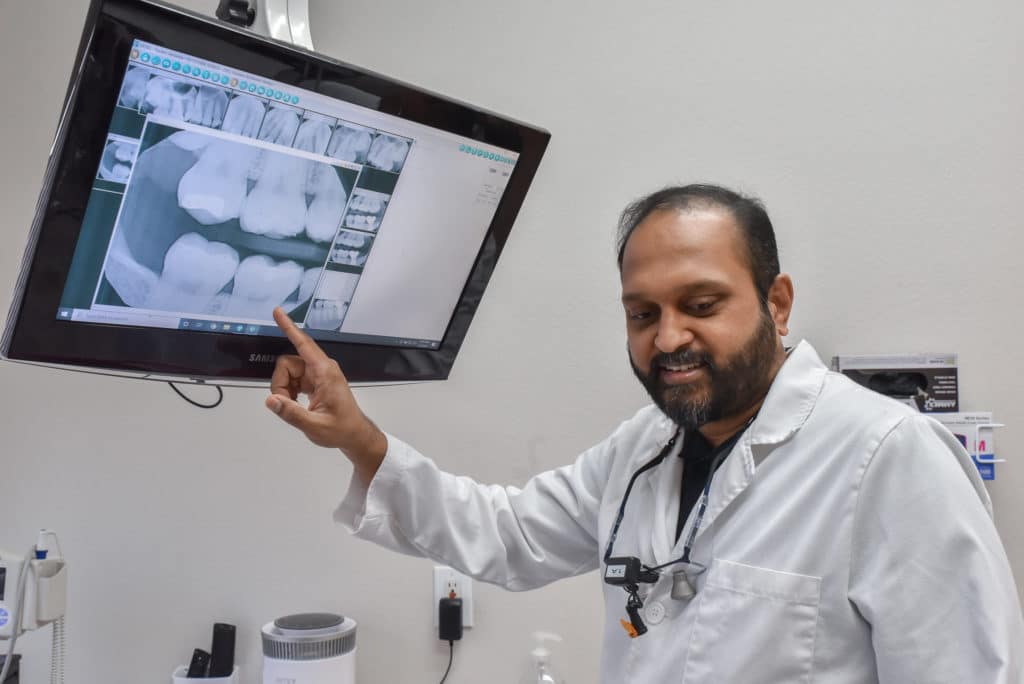
DENTAL BRIDGES IN DESOTO, TX
Bridging the gap to restore missing teeth
Missing teeth can create numerous challenges and discomfort that can erode your confidence and oral health. That’s why when it comes to restorative care, Dr. Varkey is dedicated to restoring not just your smile, but also your confidence and oral functionality. Whether you’re facing difficulties in chewing, speaking, or are self-conscious about the gap in your teeth, dental bridges offer a dependable and long-lasting solution. We craft bridges that blend seamlessly with your natural teeth, ensuring comfort, durability, and aesthetic appeal.
What are Dental Bridges?
Dental bridges are a type of dental restoration that we use to replace one or more missing teeth here at DeSoto Family Dentistry. They consist of two main components: artificial teeth, called pontics, and the dental crowns that anchor these teeth on either side. The crowns are fitted onto the teeth adjacent to the gap (known as abutment teeth), effectively bridging the space where teeth are missing.

The primary purpose of a dental bridge is to restore the function and appearance of the teeth. By filling the gap left by missing teeth, bridges help maintain the natural shape of your face, prevent remaining teeth from shifting out of position, and restore the ability to properly chew and speak. They also distribute the forces in your bite correctly, which is important for long-term oral health.
Dental bridges can be made from a variety of materials, including porcelain, ceramics, or metal alloys. These materials are chosen for their durability and ability to mimic natural teeth’ appearance. Your DeSoto dentist will help you select a material depending on the location of the missing tooth, aesthetic considerations, cost, and your preference.
What Are The Benefits?
Dental bridges offer several benefits, particularly when considering the consequences of not replacing missing teeth. Here are some of their key advantages:
- Restored Functionality: Dental bridges enable proper chewing and speaking, which can be significantly affected by missing teeth. They restore the functionality of your bite, allowing you to eat a wider range of foods and speak more clearly.
- Maintaining Facial Structure: Missing teeth can lead to a sunken facial appearance over time. Bridges help maintain the natural shape of your face by supporting the contours of your jaw and cheeks.
- Preventing Misalignment: When a tooth is missing, the surrounding teeth can shift into the empty space, leading to misalignment. Bridges fill these gaps, keeping the remaining teeth properly aligned.
- Protecting Oral Health: By preventing teeth from shifting, bridges also help reduce the risk of further dental complications, such as a misaligned bite or jaw problems, which can lead to issues like TMJ disorders.
- Aesthetic Improvement: They can significantly improve the appearance of your smile, boosting your confidence and self-esteem.
When you don’t replace missing teeth, several issues can arise:
- Teeth Shifting: Adjacent teeth may drift into the empty space, leading to misalignment and bite problems.
- Jawbone Deterioration: The absence of tooth roots leads to the loss of jawbone density, which can alter the structure of your face.
- Difficulty Chewing and Speaking: Missing teeth can make it difficult to chew food properly and affect your speech.
- Increased Risk of Oral Health Issues: Gaps in your teeth can become traps for food and bacteria, increasing the risk of tooth decay and gum disease.
Who Should Consider Dental Bridges?
Dental bridges are an ideal solution for almost any patient who is missing teeth, but particularly those who:
- Have One or More Missing Teeth: The most basic criterion for a dental bridge is the presence of one or more consecutive missing teeth. Bridges are designed to fill the gap left by these missing teeth.
- Have Healthy Abutment Teeth: To support a bridge, the teeth on either side of the gap (abutment teeth) must be strong and healthy. These teeth will be fitted with crowns that anchor the bridge in place. Alternatively, there should be dental implants in place to support the bridge.
- Seek a Non-Removable Option: Unlike dentures, which are removable, dental bridges are fixed prosthetic devices. They are a good choice for patients who prefer a more permanent solution that doesn’t require removal for cleaning or sleeping.
What To Expect

- Initial Consultation and Examination: Your journey begins with a consultation with your dentist in DeSoto, TX – Dr. Varkey – where he will examine your teeth and discuss your dental history. This step is crucial to determine if a dental bridge is the most suitable tooth replacement option for you.
- Preparing the Abutment Teeth: If a dental bridge is deemed appropriate, your dentist will prepare the abutment teeth (the teeth on either side of the missing tooth/teeth). This involves reshaping these teeth by removing a portion of the enamel to allow room for a crown to be placed over them.
- Taking Impressions: Once the abutment teeth are prepared, our DeSoto Family Dentistry team will take impressions of your teeth. These impressions are sent to a dental lab where your custom bridge, including the crowns and the false tooth (or teeth), will be created.
- Temporary Bridge Fitting: In the meantime, we’ll provide a temporary bridge to protect the exposed teeth and gums while the permanent bridge is being made.
- Fitting of the Permanent Bridge: On your next visit, the temporary bridge is removed, and the new permanent bridge is adjusted and fitted. Dr. Varkey will check and adjust the fit to ensure your comfort and proper bite alignment.
- Final Adjustments and Cementing: Once the fit is perfect, the bridge is cemented into place. This is the final step in the process, leaving you with a restored smile.
- Follow-up: We’ll schedule a follow-up visit to check the bridge, ensure you are comfortable, and make any necessary adjustments.
The entire process usually takes a couple of weeks, from the initial preparation of the abutment teeth to the final fitting of the bridge. It’s important to maintain good oral hygiene with your new bridge, including regular brushing, flossing, and dental check-ups, to ensure the longevity of the bridge and the health of your surrounding teeth and gums.
Remember, while this is a general outline, so specific details may vary based on your case and your dentist’s approach.
Frequently Asked Questions
Get a Healthy Smile Today!
Contact us & plan your visit
To schedule a visit, fill out our appointment request form or call our office. We’re looking forward to seeing you!
Related Services
No post found!